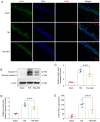Dexmedetomidine alleviates early brain injury following traumatic brain injury by inhibiting autophagy and neuroinflammation through the ROS/Nrf2 signaling pathway
- PMID: 34278508
- PMCID: PMC8335733
- DOI: 10.3892/mmr.2021.12300
Dexmedetomidine alleviates early brain injury following traumatic brain injury by inhibiting autophagy and neuroinflammation through the ROS/Nrf2 signaling pathway
Abstract
Traumatic brain injury (TBI) is a major public health problem and a major cause of mortality and disability that imposes a substantial economic burden worldwide. Dexmedetomidine (DEX), a highly selective α‑2‑adrenergic receptor agonist that functions as a sedative and analgesic with minimal respiratory depression, has been reported to alleviate early brain injury (EBI) following traumatic brain injury by reducing reactive oxygen species (ROS) production, apoptosis and autophagy. Autophagy is a programmed cell death mechanism that serves a vital role in neuronal cell death following TBI. However, the precise role of autophagy in DEX‑mediated neuroprotection following TBI has not been confirmed. The present study aimed to investigate the neuroprotective effects and potential molecular mechanisms of DEX in TBI‑induced EBI by regulating neural autophagy in a C57BL/6 mouse model. Mortality, the neurological score, brain water content, neuroinflammatory cytokine levels, ROS production, malondialdehyde levels and neuronal death were evaluated by TUNEL staining, Evans blue extravasation, ELISA, analysis of ROS/lipid peroxidation and western blotting. The results showed that DEX treatment markedly increased the survival rate and neurological score, increased neuron survival, decreased the expression of the LC3, Beclin‑1 and NF‑κB proteins, as well as the cytokines IL‑1β, IL‑6 and TNF‑α, which indicated that DEX‑mediated inhibition of autophagy and neuroinflammation ameliorated neuronal death following TBI. The neuroprotective capacity of DEX is partly dependent on the ROS/nuclear factor erythroid 2‑related factor 2 signaling pathway. Taken together, the results of the present study indicated that DEX improves neurological outcomes in mice and reduces neuronal death by protecting against neural autophagy and neuroinflammation.
Keywords: autophagy; dexmedetomidine; early brain injury; neuroinflammation; traumatic brain injury.
Conflict of interest statement
The authors declare that they have no competing interests.
Figures







References
-
- Rowell SE, Meier EN, McKnight B, Kannas D, May S, Sheehan K, Bulger EM, Idris AH, Christenson J, Morrison LJ, et al. Effect of out-of-Hospital tranexamic acid vs placebo on 6-month functional neurologic outcomes in patients with moderate or severe traumatic brain Injury. JAMA. 2020;324:961–974. doi: 10.1001/jama.2020.8958. - DOI - PMC - PubMed
MeSH terms
Substances
LinkOut - more resources
Full Text Sources
Medical

